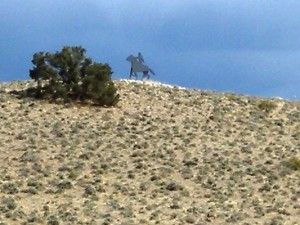» posted on Saturday, April 21st, 2012 by Linda Lou Burton
Coming Through
 Linda Burton posting from Carson City, Nevada – A painted blue line shows the way, accented by bronze medallions implanted in the sidewalk beneath my feet. The pear trees are in bloom today and it’s an easy downtown walk along the Kit Carson Trail, 2.5 miles of history, where I’m promised a pedestrian’s-eye glimpse of the past. Modern-day technology in the form of a podcast reveals the juicy bits and basic facts; 64 landmarks to see, and think about. Who came here, and when? Who stayed, and who passed on through?
Linda Burton posting from Carson City, Nevada – A painted blue line shows the way, accented by bronze medallions implanted in the sidewalk beneath my feet. The pear trees are in bloom today and it’s an easy downtown walk along the Kit Carson Trail, 2.5 miles of history, where I’m promised a pedestrian’s-eye glimpse of the past. Modern-day technology in the form of a podcast reveals the juicy bits and basic facts; 64 landmarks to see, and think about. Who came here, and when? Who stayed, and who passed on through?
It’s nice that someone put this together for us to see. Good citizens and lovers of history have made sure we can follow many “trails of the past” – like the Pony Express Trail (a plaque at Robinson and Carson reminds us); and the American Discovery Trail, a coast-to-coast endeavor extending from Delaware to California. It comes through just north of town. Are you familiar with the ADT?
The American Discovery Trail goes back to 1989, when folks at the American Hiking Society and Backpacker magazine came up with the idea of a coast to coast trail; the route was selected by working with local, state and federal land managers. In 1990-91 the trail was mapped out; of course it is an ongoing effort, with volunteer coordinators in each state through which the trail passes.
The non-motorized ADT covers 6,800 miles; the idea is to link communities and give us the chance to discover the spirit of America. Passing through cities and towns, forests and deserts, it connects five national scenic trails, 10 national historic trails, and 23 national recreational trails; it leads to 14 national parks and 16 national forests; and it visits 10,000 sites of historic, cultural and natural significance.
The Nevada part has nine segments totaling 496 miles from Great Basin National Park to Tahoe; the Nevada office is located in Carson City; hikers, historians, and volunteers, step up. http://www.discoverytrail.org/states/nevada/index.html
 There’s overlap between the ADT and the Pony Express Trail I mentioned earlier. There were 30 stations in the 420-mile route across Nevada; the Carson City station is gone today, but it was located on Carson Street between 4th and 5th, near the original Ormsby House. That’s where a fresh horse would be waiting for each young, wiry rider; he’d quickly transfer the leather mochila containing the carefully wrapped mail to the next saddle, and be off.
There’s overlap between the ADT and the Pony Express Trail I mentioned earlier. There were 30 stations in the 420-mile route across Nevada; the Carson City station is gone today, but it was located on Carson Street between 4th and 5th, near the original Ormsby House. That’s where a fresh horse would be waiting for each young, wiry rider; he’d quickly transfer the leather mochila containing the carefully wrapped mail to the next saddle, and be off.
“Orphans preferred” read the ad offering jobs in this dangerous mail delivery business that lasted only 18 months. Though it was not a financial success, it was the transcontinental telegraph that brought about its demise. During its time, from April 1860 till October 1861, the mail was delivered between St Joseph, Missouri and Sacramento, California.
 Highway 50 parallels some of the trail today in Nevada; get maps from the Bureau of Land Management in Carson City and take a drive on what some have dubbed “the loneliest highway in America.” In the hills near Carson Highlands you’ll see a tribute to the Pony Express; a 10 x 10 foot silhouette of a lonely rider on a horse, created by artist Bill Muerle of Carson Valley.
Highway 50 parallels some of the trail today in Nevada; get maps from the Bureau of Land Management in Carson City and take a drive on what some have dubbed “the loneliest highway in America.” In the hills near Carson Highlands you’ll see a tribute to the Pony Express; a 10 x 10 foot silhouette of a lonely rider on a horse, created by artist Bill Muerle of Carson Valley.
http://ponyexpressnevada.com/pony-express-loneliest-road.html
http://www.xphomestation.com/carson-city-silhouette.html
A lot has happened since 1841, when Kit Carson came through, mapping out the west. These trails are a living history book; our thanks to all who make them possible for us to enjoy today. The Carson City Convention and Visitors Bureau makes the Kit Carson Trail podcast available for home listeners too.
http://www.visitcarsoncity.com/tours/kitcarson_talkinghouses.php
